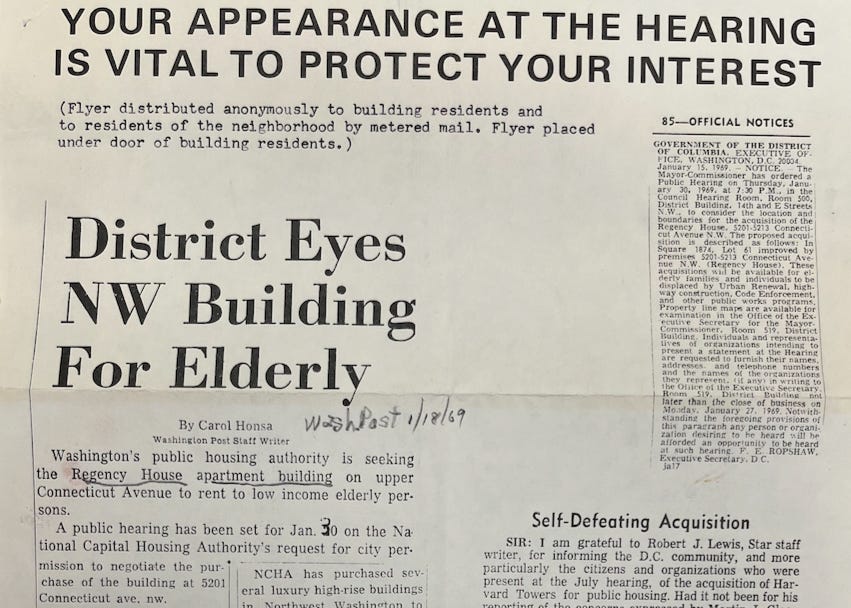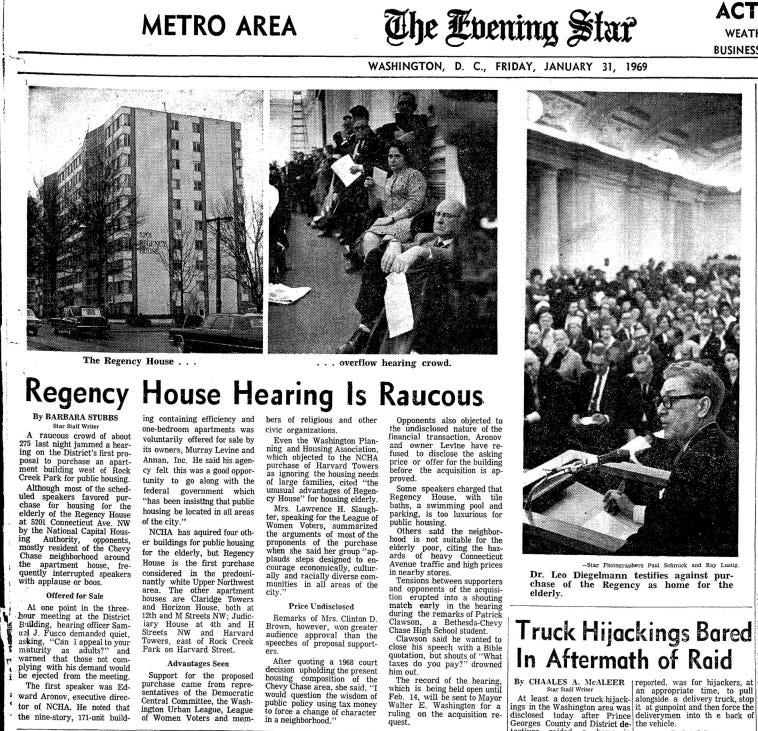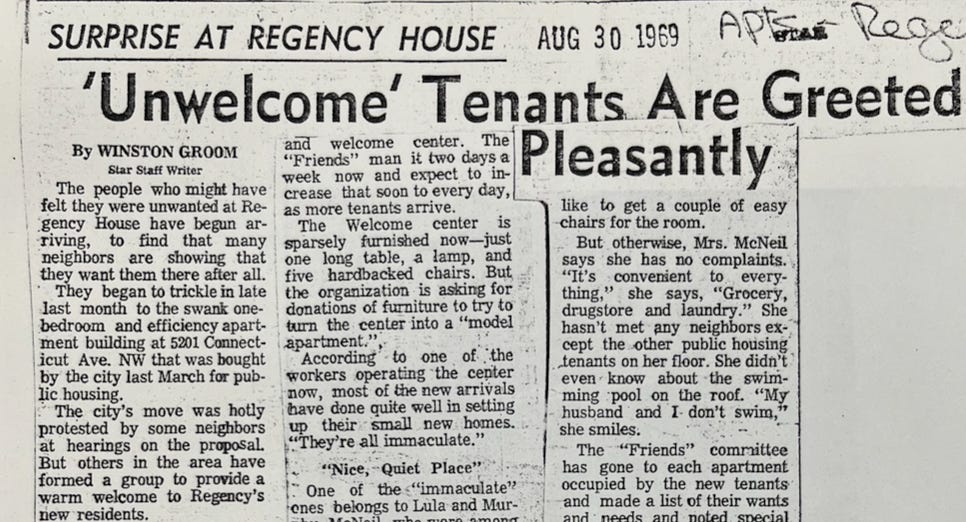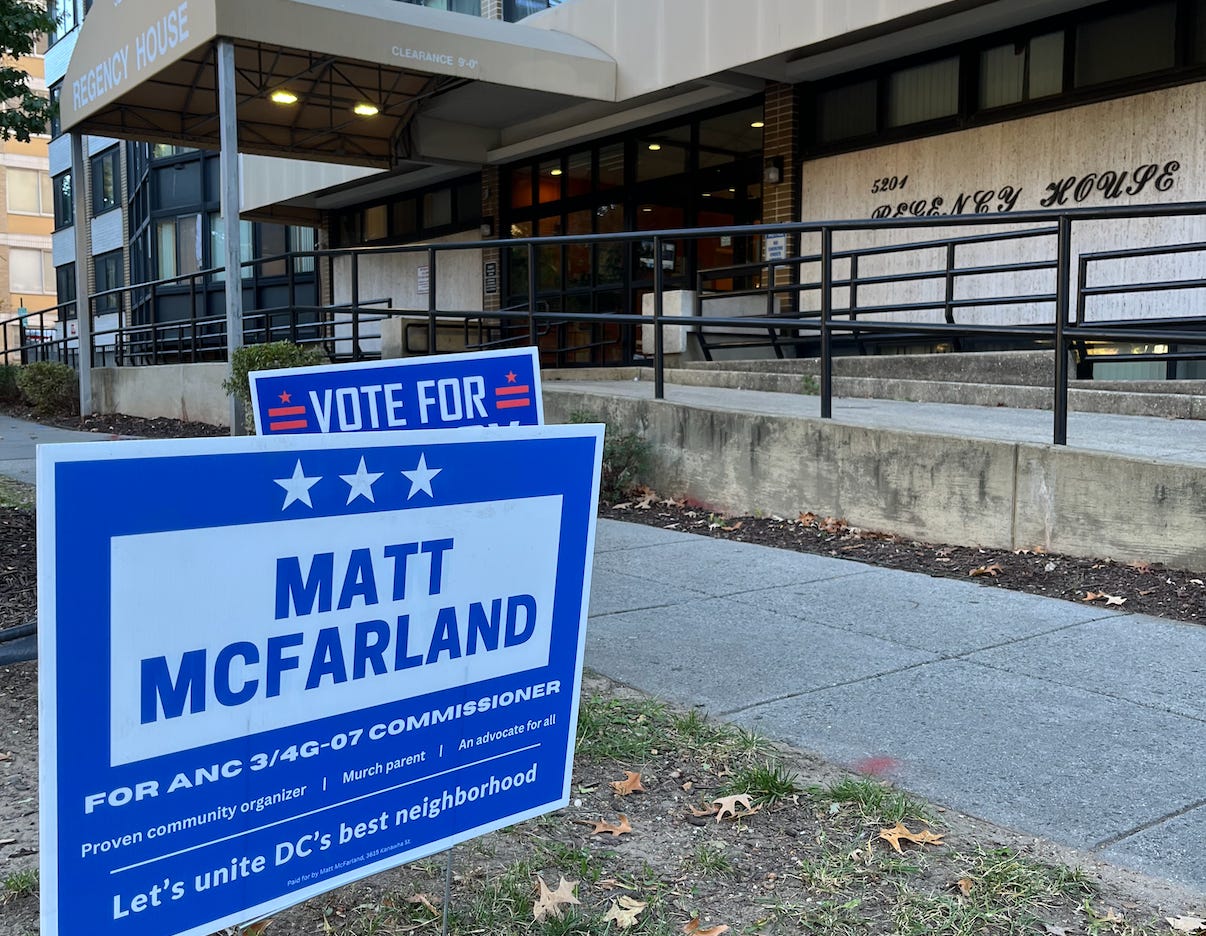When Chevy Chase was divided over Regency House in 1969
The history of the first public housing West of Rock Creek Park

I’m running for ANC commissioner in 3/4G-07, where the first DC public housing West of Rock Creek Park opened in 1969. I dug into the DC library archives to better understand its history:
Regency House opened at 5201 Connecticut Avenue in the 1960s. “Luxury living at sensible prices,” read classified ads. “Swim in rooftop pool. Relax on sundeck.”
But its owners, Murray Levine and Annan Inc., were willing to sell it a few years after it opened.
DC Mayor Walter Washington felt that its layout -- efficiencies and one-bedrooms -- made it ideal for the elderly. He proposed that DC make it public housing for anyone over age 62. There were 1,145 elderly on the city’s public housing waitlist.
Buying the building would give DC a 172-unit building without having to wait several years for new construction. The city had also struggled to buy land for new buildings at prices it could afford.
There was no public housing West of Rock Creek Park in early 1969. Chevy Chase was a White neighborhood. Washington said that buying Regency House would help the city comply with new federal guidelines that called for ending a concentration of public housing in certain sections of cities.
Chevy Chase neighbors were divided.
The plan would force existing Regency House residents to move out within a year. They’d receive $200 for moving expenses.
It would also change the racial and economic makeup of the White neighborhood. New residents would be mostly Black. Rents that had been $137.50-$200 a month would fall to $50 to $55 a month.
A flyer was distributed to neighbors urging them to attend a city hearing on the purchase. It was critical of the potential acquisition. “It seems too incredible for words that a person on welfare will be afforded living accommodations which exceed the level, as a lawyer friend of mine said, ‘my own mother is accustomed to.’ ”
“A raucous crowd of about 275 last night jammed a hearing,” the Evening Star recounted. “Opponents, mostly residents of the Chevy Chase neighborhood around the apartment house, frequently interrupted speakers with applause or boos.”
The Star reported that “hearing officer Samuel J. Fusco demanded quiet, asking, ‘Can I appeal to your maturity as adults?’”
A Chevy Chase Citizens Association meeting a few weeks later drew 500 people, most of whom were critical of the Regency House purchase, according to reports. One woman called it “the first step in a ‘block-busting’ plan,” according to the Washington Star.
The tension also played out in letters to the editors in local newspapers like The Washington Star and The Washington Post.
“Why is it morally right to evict Peter to house Paul?,” wrote DC resident Samuel Rosenberg. “We do not like public housing projects in our neighborhood. Public housing belongs in low-price neighborhoods. In this way, the taxpayers stand to get the most for their money and more people in need of housing can be accommodated.”
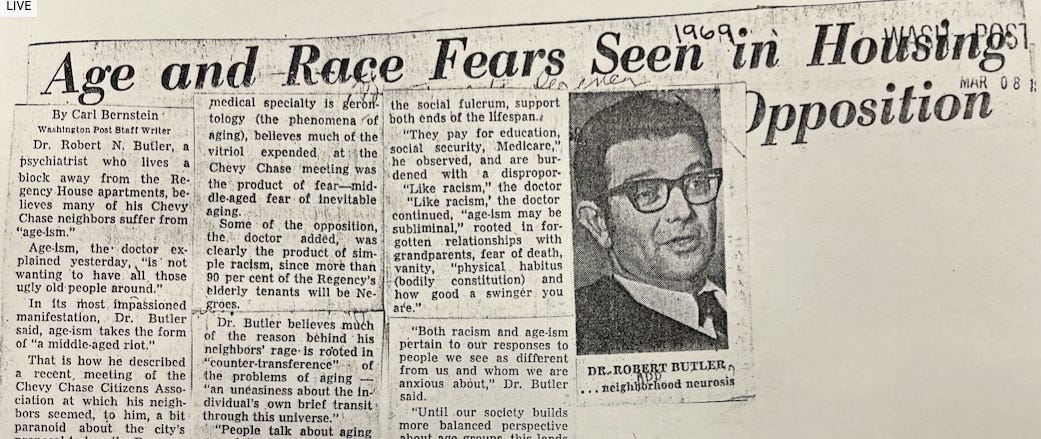
Some critics objected to public housing having amenities like air conditioning and a swimming pool.
“You open the door for people who simply don’t know how to live,” was one argument against, according to a Washington Star story.
That caught Mayor Washington’s attention.
“Statements from west-of-the-park white liberals that people on public housing wouldn’t know how to take care of a ‘luxury’ building like Regency House made [Mayor Washington] even more determined to see it through,” The Post reported.
Many supported Washington’s plan.
“The interests of West-of-the-Park Washington cannot be pursued in an isolationist spirit, and that pleasant living for some of us in Washington can only be a permanent reality when living in Washington is pleasant for all its citizens,” Eric W. Beshers, chairman, Northwest Parents Action Group, wrote in a letter to the editor.
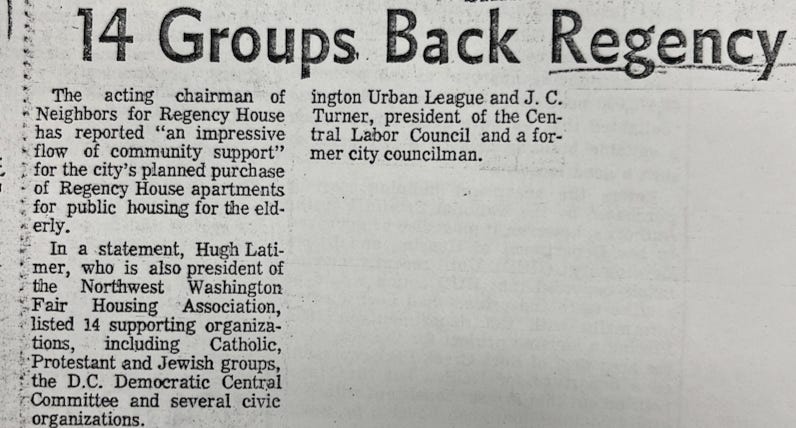
Washington signed off on the $2.475 million purchase in March 1969.
One criticism was the price tag for Regency House, $125,000 over an appraisal of the building.
The deal still needed signoff from the Department of Housing and Urban Development (HUD). It told the mayor that the community would have to come up with $125,000 to cover the gap between the building’s appraisal and the seller’s price.
Mayor Washington scrambled to raise money from six foundations, including the Eugene and Agnes E. Meyer Foundation.
“If we can’t make this project, [Washington] said, we can’t ever make public housing effective here, and the whole program is doomed,” The Post reported.
The mayor told friends that finding the money to save the project was “the most demanding thing I’ve ever had to do,” according to a Post story. The sellers agreed to drop their price by $50,000, and Washington came up with the rest of the money.
HUD approved the sale in May 1969. Its news release was described as “cold” by The Post, as Republicans had been critical of the project and HUD was led by a President Nixon appointee.
New residents started to move in.
Ruth Dade, who had waited 28 months for public housing, described her Regency House room as “the answer to my prayers,” in a Post story. She grew up in DC. Her first house on Spring Road was “across from an ash dump where her grandmother used to look for coal.”
Some headlines described an ease of tension, and many neighbors welcoming the new residents. Local religious groups that had rallied behind the project engaged new residents in an ecumenical center in the building. The rooftop pool didn’t remain open.
“The poor people moving in [has] made no difference. There’s been no trouble whatsoever, and I’m going to stay as long as I can in the neighborhood,” Patrick Fitzgibbons, a 37-year resident of Chevy Chase, said in an October 1969 Daily News story.
The Post revisited Regency House a year after the sale and reported that “most real estate agents say houses are still selling for what they would expect in that area, although some say ‘it’s still too soon to tell.’ The exit to the suburbs did not materialize. It is hard to find a complaint about the new tenants.”
Studying the history of Regency House reminded me of our current debate in Chevy Chase over adding housing at the library and community center. I also thought of a line often credited to Mark Twain -- history never repeats itself, but it does often rhyme.




